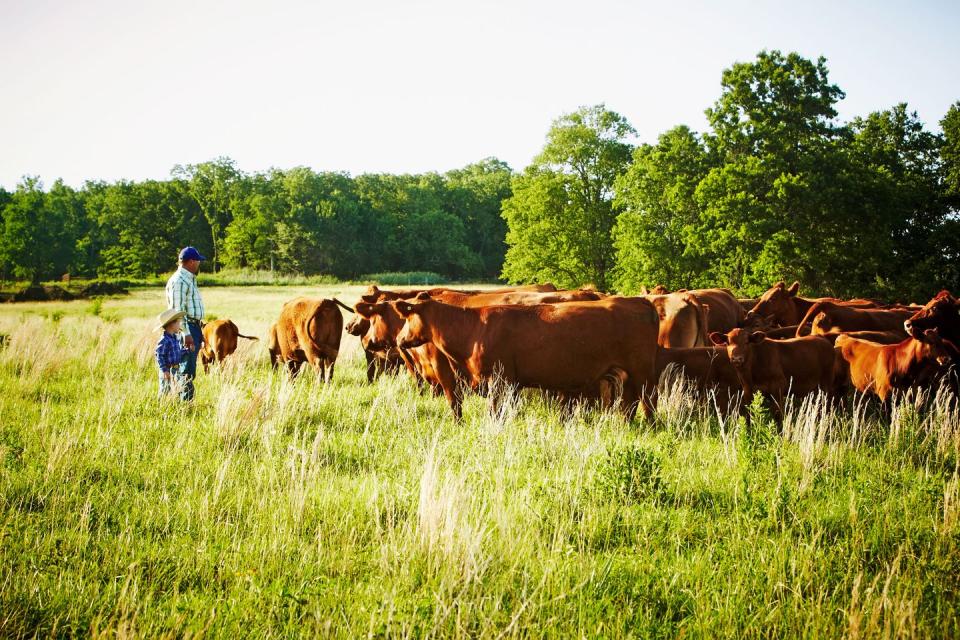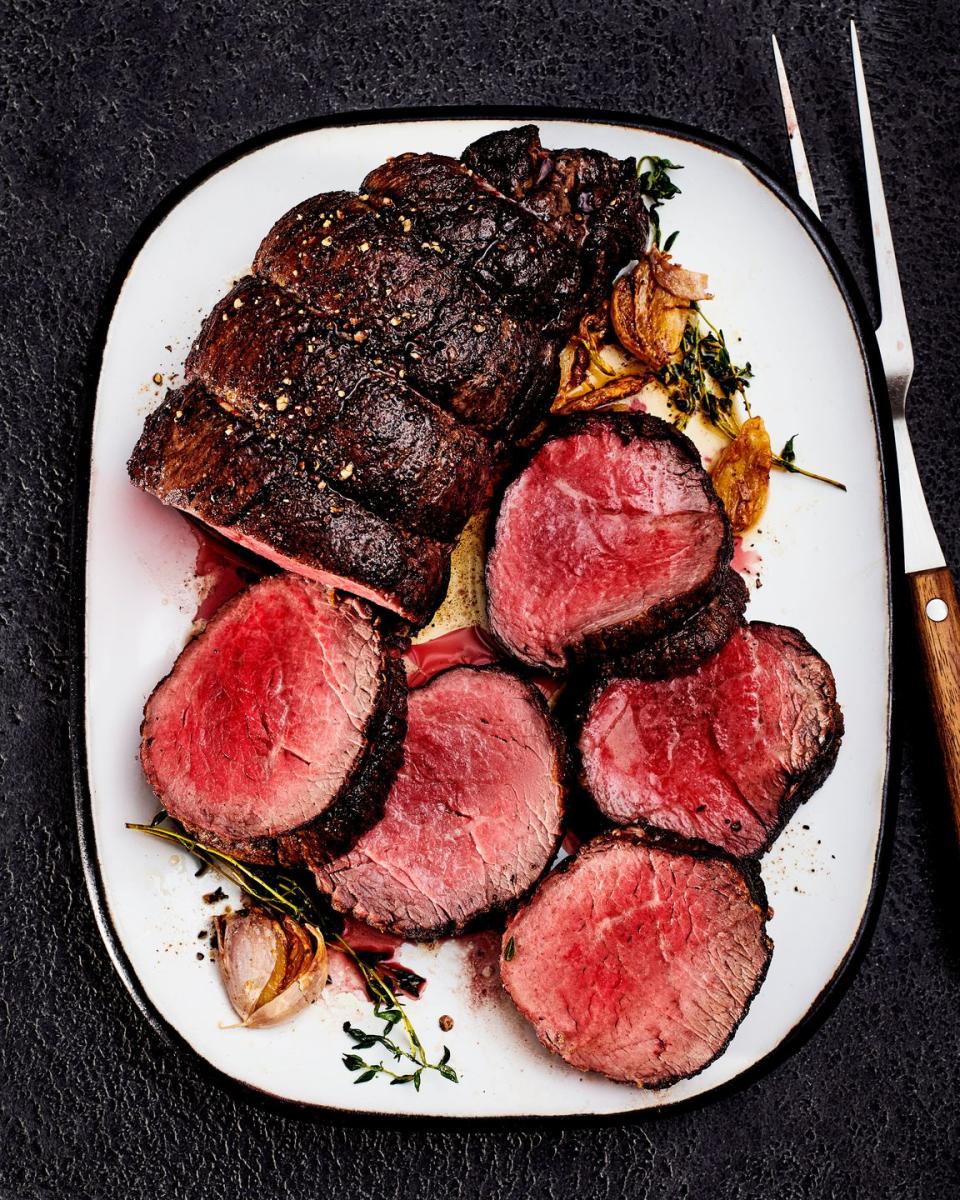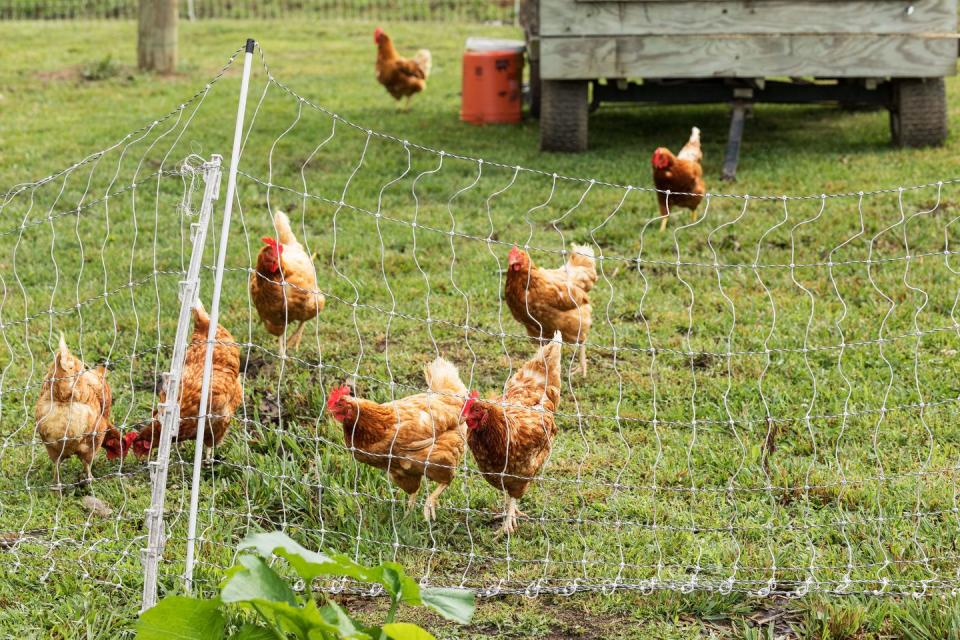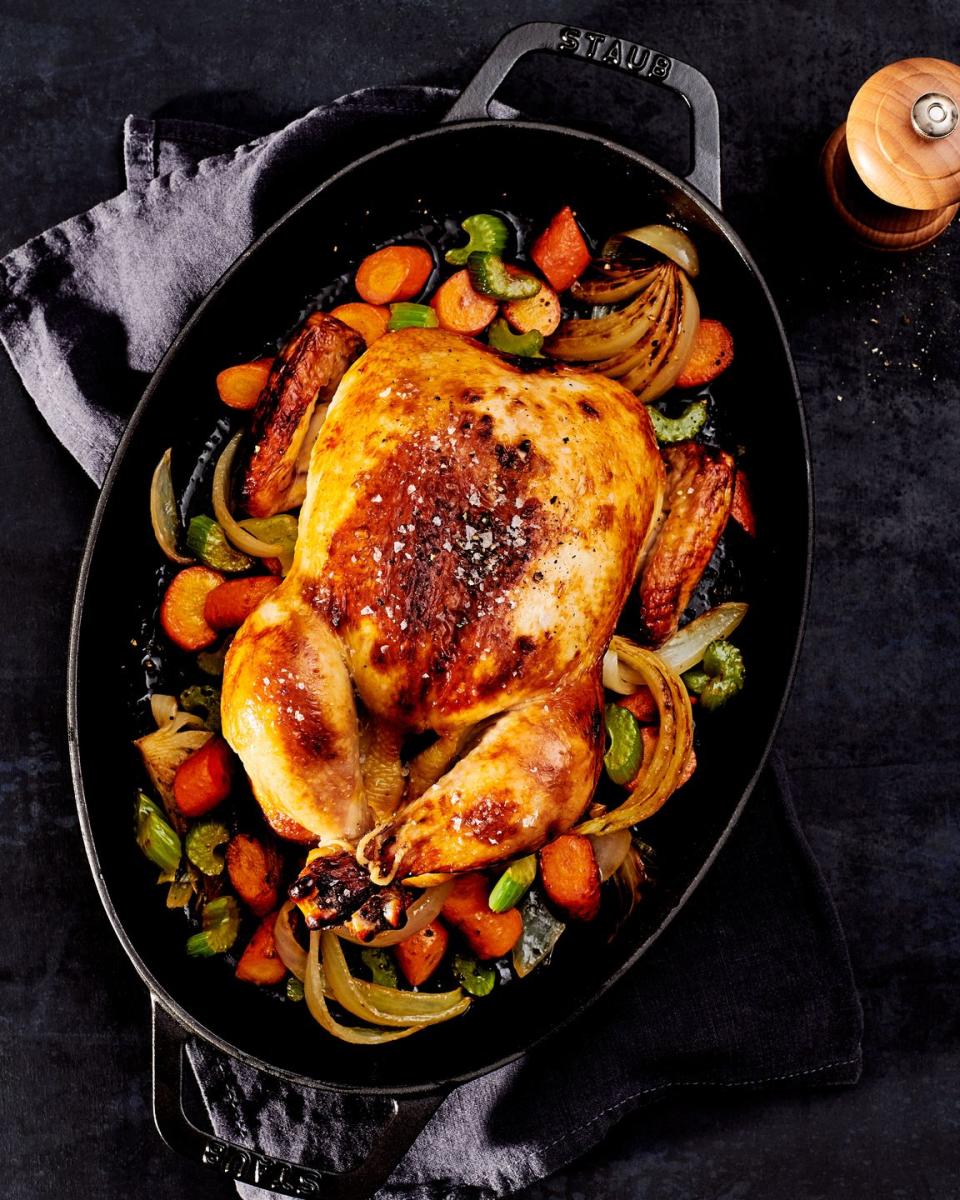The Golden Age of Mail-Order Protein Has Arrived
CALL IT a great protein flavor recession: Over the past few decades, something happened to grocery-store beef, chicken, and fish—it started to all taste the same.
The main culprit: industrial farms producing bland meat and giving animal protein a bad name. (No wonder plant-based “meat” took off.)
But now smaller-scale farms are raising this-is-how-it-should-taste animal proteins, while also enhancing the nutritiousness of their products. Better still: You can have them shipped to you.
Here are just three of the many producers offering the Good Stuff, plus how to cook it right.
Beef: Meet Regenerative Ranching’s Underdog
THERE’S ONE big reason the meat you eat at a steakhouse tastes sublime: sourcing.
Steakhouse owners know that delivering a tender, juicy, belly-patting rib eye (ortomahawk, or . . .) starts not in the kitchen but on the cattle ranch.
Enter Adam LaRoche. When he retired from baseball in 2016, he found himself with plenty of two things: land and time. LaRoche had opened a steakhouse back in 2013 and owned a 4,800-acre ranch in Fort Scott, Kansas.
He had big dreams of raising better cattle that would help supply the steakhouse and sustain his family for generations to come. And so, with his business partner, rancher Jake Gross, he cofounded E3 Meat Co.

LaRoche and Gross began by looking at the dirt. Healthy earth makes healthy grass, which makes healthy cattle, which makes healthy meat, which makes healthy people, says Gross.
Their first change was to introduce paddock grazing, in which the cattle eat only choice grasses (yes,they can discern a difference) rather than consuming all the grass, which is tough on the soil—and poor soil demands chemical fertilizers and herbicides.

The ranch has also implemented low-stress cattle-management practices, raising the animals without using steroids or antibiotics, and never added hormones. The result: luscious marbled cuts of deeply beefy steak.
While grass-fed is trendy, E3 grain-finishes its beef. That means the flavor is familiar—powerfully hearty and almost buttery—yet elevated, like a chop you’re used to having at a steakhouse, only enjoyed at home.
Steak packages, starting at $100, are available through e3ranch.com.
Sear-Roasted Beef Tenderloin Steaks
Recipe by Cassidee Dabney, executive chef of the Barn at Blackberry Farm in Walland, Tennessee

If you’re buying by mail order, you can often pick up specialty cuts—such as beef tenderloin roast, a massive hunk of lean meat that cooks up so sublime you can skip the steak knife. Fear not screwing it up: “Dividing the tenderloin into two roasts is a great option if you have multiple meat-temp needs in your house,” says Dabney.
▼ What You'll Need:
• 1 (5 to 7 lb) trimmed beef tenderloin, halved to make 2 roasts
• 2 Tbsp canola oil
• 2 Tbsp butter
• 3 whole garlic cloves, smashed
• 3 fresh thyme sprigs
▼ How to Make It:
1. Pat the tenderloin dry with paper towels and allow it to rest at room temp for 2 hours.
2. Preheat your oven to 425°F. Heat a large cast-iron pan over medium high. Generously season the tenderloin with kosher salt and freshly ground black pepper. Add the oil to the pan and, when it begins to shimmer, sear the 2 roasts on all sides, 3 to 4 minutes a side.
3. Remove the tenderloin from the pan and transfer it to a roasting pan. (Do not clean out the cast-iron pan.) Roast the meat about 10 to 15 minutes for rare, plus 5 to 10 additional minutes for every level of doneness thereafter.
4. Carefully remove the tenderloin from the oven. Heat the cast-iron pan over medium. Melt 2 Tbsp butter and add the garlic, thyme, and roasts; baste for 1 to 2 minutes. Transfer the roasts to a cutting board, let them rest for 5 to 10 minutes, then slice and serve, topping with a little melted butter and pan drippings.
Feeds 14 to 16
Chicken: Pastured Poultry Is the Future
IF YOU’VE been unimpressed with organic or free-rangesupermarket chicken, paying a few bucks more for a still-bland bird, Cody Hopkins gets it.
When he started his small farm in Arkansas in 2006, he bought a few chickens to raise for meat, largely because, well, they were cheap. Counter to the way most industrial-farm chickens are raised(crowded together in warehouse-like buildings and given feed), Hopkins put his chickens in portable pens. He moved the pens every few days so the birds could peck fresh grass and clover.
This simple act infused the meat with bold, almost floral flavors. “There’s a big difference between our chickens and ones raised in a chicken house—those chickens will never see the light of day,” he says. (“Free range” just means the birds can go outside—not that they actually do go outside.)

And, due to their diet, pasture-raised chickens have higher levels of good polyunsaturated fats when compared with conventionally raised chickens, according to 2018 research by the Institute of Animal Science in Bulgaria.
Though Hopkins had exceptional chickens, he couldn’t find a processing plant that was willing to work with his small outfit. In the U. S., 18 large corporate farming operations, including Tyson, Perdue, and Pilgrim’s Pride, control an estimated 90 percent of the meat-chicken industry, and these companies often own their own processing facilities.
So Hopkins and other like-minded farmers partnered with the nonprofit Heifer International to start Grass Roots Farmers’ Cooperative, a coalition that shares processing resources.
The group, founded in 2014, is now run out of 24 farms in eight states and ships nationwide, its pasture-raised chicken a best seller. It’s $21 for a whole bird at grassrootscoop.com.
Yogurt-Marinated Roast Chicken
Recipe by John Fraser, chef-owner of Iris in New York City

High-quality pastured chicken has an almost herbal flavor. Highlight that by marinating the bird in an herbed yogurt mixture. “The acids in the yogurt will help to tenderize the meat,” says Fraser.
▼ What You'll Need:
• 1 3/4 cup labneh or 4 percent plain Greek yogurt
• 1/2 cup olive oil, plus 1 Tbsp
• 2 garlic cloves, minced
• Zest from 1 lemon, plus 1 tsp juice
• 1/4 tsp minced parsley
• 1/2 tsp minced rosemary
• 1 pinch saffron (optional)
• 1 (3 to 4 lb) pasture-raised whole chicken, giblets removed
• 1 onion, large diced
• 3 ribs celery, large diced
• 1 carrot, large diced
▼ How to Make It:
1. In a bowl large enough to fit the chicken, combine the labneh or yogurt, 1/2 cup olive oil, garlic, lemon zest, parsley, rosemary, saffron (if using), 2 tsp salt, and 1/4 tsp freshly ground black pepper. Add the chicken, coat well with the yogurt mixture, and marinate in the refrigerator, covered, for 12 hours.
2. Preheat your oven to 350°F. Rinse the chicken and pat it dry with a paper towel. Transfer the vegetables to the bottom of a large roasting pan, sprinkle with sea salt, and add the chicken, breast side up. Tie the legs together, close to the body of the chicken, with twine. Rub the 1 Tbsp olive oil all over the chicken and sprinkle with 1 Tbsp sea salt.
3. Roast the chicken until a meat thermometer inserted into the thickest parts of the breast and thighs reaches 165°F, about 90 minutes. Carefully remove the chicken from the oven and let it rest for 15 minutes before carving.
Feeds 6
Fish: This Farmed Salmon Is a (Very) Good Thing
YOU’VE HEARD about all the studies: People who eat fish rich in omega-3 fatty acids may reduce their risk of stroke, heart failure, Alzheimer’s disease, and even depression.
Yet Americans are still consuming only about one third of the weekly recommendation of eight ounces of fish and shellfish, according to the latest data from the USDA.
But the fish farmers behind the company New Zealand King Salmon are raising salmon so delicious that it’s hard not to want to eat more of it—and it’s all due to fat.
After cultivating nine generations of fish, the company has managed to produce a salmon that has a fat content of 25 percent, says Michael Fabbro, vice president of New Zealand King Salmon’s North American operation.
“If you were to compare that with wild salmon, it would be between 12 and 15 percent fat,” he says. (And the fattier the fish, the greater the amounts of DHA and EPA, two omega-3 fatty acids beneficial to your heart and brain.)

To raise its salmon, the company employs football-field-sized net pens that are 98 percent water and 2 percent fish. “At that density level, the waste is naturally composted by the organisms on the seabed; it doesn’t build up,” Fabbro says.
This method works incredibly well; in fact, Monterey Bay Aquarium’s Seafood Watch rates New Zealand salmon raised in open-water net pens a “best choice” for sustainability—that’s even better than wild-caught salmon from the U. S. and Canada.
You can order four pounds of New Zealand King Salmon (under the brand name Ōra King Salmon) for $120 from Browne Trading Company at brownetrading.com.
Jerk Salmon
Recipe by executive chef Edward Brumfield of the Marcus Samuelsson Group

The heat and spice in this recipe’s jerk marinade tag-team with the richness of high-fat farmed salmon.
▼ What You'll Need:
• 1 head garlic, minced
• 1 cup chopped scallions
• 1 cup cilantro leaves, loosely packed, plus sprigs for serving
• 1 Scotch Bonnet pepper or habanero, stemmed
• 1 (1-inch) piece fresh ginger, peeled and chopped
• 2/3 cup molasses
• 2/3 cup olive oil
• 1 tsp ground allspice
• 1/2 tsp ground cinnamon
• 4 (6 oz) skinless farm-raised salmon fillets
• Lime wedges, for serving
▼ How to Make It:
1. In a blender or food processor, add the garlic, scallions, 1 cup cilantro leaves, hot pepper, ginger, molasses, olive oil, allspice, and cinnamon. Season to taste with salt. Puree till smooth.
2. In a large bowl, combine the salmon with half the pureed jerk marinade; turn the fish to coat well. Refrigerate for 15 minutes.
3. Preheat your oven to 375°F. Place the salmon on a nonstick baking sheet, pour the rest of the marinade over it, and roast until flaky, 8 to 10 minutes. Serve with the lime wedges and cilantro sprigs.
Feeds 4
A version of this article originally appeared in the March 2021 issue of Men's Health.
You Might Also Like

